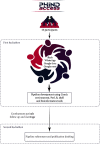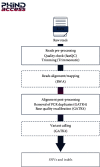PHINDaccess Hackathons for COVID-19 and Host-Pathogen Interaction: Lessons Learned and Recommendations for Low- and Middle-Income Countries
- PMID: 37854792
- PMCID: PMC10581832
- DOI: 10.1155/2023/6638714
PHINDaccess Hackathons for COVID-19 and Host-Pathogen Interaction: Lessons Learned and Recommendations for Low- and Middle-Income Countries
Abstract
Hackathons are collaborative events that bring together diverse groups to solve predefined challenges. The COVID-19 pandemic caused by SARS-CoV-2 has emphasized the need for portable and reproducible genomics analysis pipelines to study the genetic susceptibility of the human host and investigate human-SARS-CoV-2 protein interactions. To build and strengthen institutional capacities in OMICS data analysis applied to host-pathogen interaction (HPI), the PHINDaccess project organized two hackathons in 2020 and 2021. These hackathons are aimed at developing bioinformatics pipelines related to the SARS-CoV-2 viral genome, its phylodynamic transmission, and the identification of human genome host variants, with a focus on addressing global health challenges, particularly in low- and middle-income countries (LMIC). This paper outlines the preparation, proceedings, and lessons learned from these hackathons, including the challenges faced by participants and our recommendations based on our experience for organizing hackathons in LMIC and beyond.
Copyright © 2023 Kais Ghedira et al.
Conflict of interest statement
The authors declare no conflict of interest.
Figures





References
MeSH terms
LinkOut - more resources
Full Text Sources
Medical
Miscellaneous

